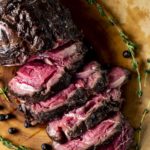Sous Vide Venison
Sous Vide Venison is moist and tender, slow cooked to medium-rare in a red wine broth and seasoned with fresh thyme and juniper berries!
Servings: 4 people
Calories: 733kcal
Ingredients
- 1 ½ - 2 pounds venison loin
- 1 tablespoon salt
- ¼ cup red wine
- ¼ teaspoon black pepper
- 1 teaspoon juniper berries crushed
- 1 tablespoon brandy
- 2 tablespoons butter
- 2 sprigs fresh thyme
- ¼ cup chicken or beef stock
- 2 tablespoons avocado oil for searing
Instructions
- Rub the salt all over the venison loin and place in the fridge, uncovered, overnight or for 8 hours.
- Heat a sous vide water bath to 131F degrees.
- Place the venison in a vacuum seal bag with the remaining ingredients (except avocado oil).
- Vacuum seal and cook in the water bath for 6 hours.
- Remove and take the venison out of the bag, reserving the bag juice.
- Simmer the bag juice in a pan (add extra stock if too thin or salty) for 3-5 minutes.
- Heat a skillet on medium high heat and add the avocado oil.
- Sear the venison on all sides for about 30 seconds per side, until a brown crust has formed. (Be careful not to sear too long or your venison will overcook).
- Remove and let sit for 3-5 minutes (until cool enough to slice).
- Slice and serve drizzled with the bag juice.
Notes
- For the best results, let the salted venison sit in the fridge uncovered overnight. This helps it tenderize and seals in the juices.
- Be sure to seal the vacuum seal or ziplock bag properly to remove the air and avoid bacteria entering the bag.
- If air gets in the bag while the venison loin is cooking, open the sealable bag or ziplock bag, remove the air and seal it again.
- The bag should be fully submerged in the water bath so the venison cooks evenly and safely. To prevent the bag from floating, you can use something heavy like a sous vide sinker weight.
- For a good crust, once the venison comes out of the water bath, pat it dry with paper towels before searing it.
- For searing, make sure you use avocado oil or another oil with a high smoke point.
- If the bag juice is too thick or too salty, you can add more broth or even water.
- When it comes to broth, I like to use low sodium or homemade broth so I can control the saltiness of the venison. You can always add more salt to taste.
Nutrition
Serving: 6ounces | Calories: 733kcal | Carbohydrates: 1g | Protein: 120g | Fat: 22g | Saturated Fat: 8g | Polyunsaturated Fat: 2g | Monounsaturated Fat: 8g | Trans Fat: 1g | Cholesterol: 329mg | Sodium: 2021mg | Potassium: 1606mg | Fiber: 1g | Sugar: 1g | Vitamin A: 200IU | Vitamin C: 1mg | Calcium: 30mg | Iron: 16mg
